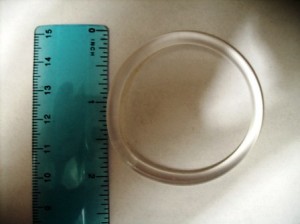NuvaRing — Evaluating Convenience and Safety
For many young women, the introduction of the NuvaRing in 2001 as an alternate form of birth control seemed to be just the right fit for their active lifestyles. They no longer had to worry about taking a pill at the same time every day.
This new form of contraceptive could be inserted vaginally by the user, left in place for three weeks, removed for one week to allow for menstruation, and then a new ring inserted continuing this pattern.
Just like oral contraceptives, the NuvaRing contains estrogen and progestin. These two hormones work together to prevent the ovaries from releasing mature eggs and thinning the uterine lining to prevent implantation of a fertilized egg. Once inserted, the ring releases a low dose of hormones which are absorbed and distributed throughout the bloodstream.
When used as directed, the NuvaRing claims to be just as effective as the pill, preventing 99%of pregnancies.
So why not use this much more convenient method of administration?
Studies demonstrate that third-generation contraceptives, such as the NuvaRing, can double the risk of life-threatening blood clots when compared to second-generation contraceptives. These blood clots can lead to:
- Myocardial infarction (heart attack)
- Cerebrovascular accident (stroke)
- Elevated blood pressure
- Pulmonary embolism (blood clot obstructing the lungs)
- Deep vein thrombosis (blood clot in deep veins, usually in the leg)
- Gall bladder disease
- Ocular lesions
- Death
The culprit in these third-generation contraceptives is the progestin component called desogestrel, which was developed to replace the norgestrel, levonorgestrel or norethindrone found in the second-generation pills.
This newest class of contraceptives was introduced with the intention of reducing adverse reactions such as acne and excessive hair growth associated with the second-generation predecessors.
If you have been using NuvaRing and develop any of the following side effects, please immediately consult with your physician:
- Chest pain
- Difficult breathing—shortness of breath or labored breathing
- Coughing up blood
- Severe headaches
- Weakness or numbness
- Pain in the arms or legs (especially calf or thigh)
- Vision loss
- Flashing lights in the field of vision
- Severe abdominal pain
- Jaundice (yellowing of the skin or eyes)
- Unusual breast lumps
- Drastic change in mood
- Sever fatigue
- Sleeplessness for an extended period
Trading clearer skin for the risk of life-threatening blood clots just doesn’t add up! So while it may be more inconvenient, the daily dosing required with the second-generation pills seems like the obvious and safer choice. They offer exactly the same benefits of efficacy as the NuvaRing, without the heightened risks of life-threatening injury and death.
In a world where we seem to be placing so much emphasis on cosmetic perfection… “Is the risk worth the reward?”
Share This



